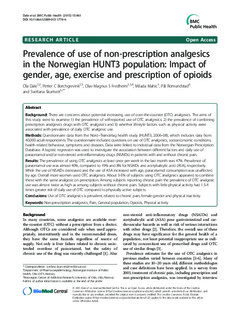| dc.contributor.author | Dale, Ola | |
| dc.contributor.author | Borchgrevink, Petter Chr. | |
| dc.contributor.author | Fredheim, Olav Magnus | |
| dc.contributor.author | Mahic, Milada | |
| dc.contributor.author | Romundstad, Pål Richard | |
| dc.contributor.author | Skurtveit, Svetlana | |
| dc.date.accessioned | 2015-09-11T12:45:32Z | |
| dc.date.accessioned | 2015-09-28T12:41:26Z | |
| dc.date.available | 2015-09-11T12:45:32Z | |
| dc.date.available | 2015-09-28T12:41:26Z | |
| dc.date.issued | 2015 | |
| dc.identifier.citation | BMC Public Health 2015, 15(461) | nb_NO |
| dc.identifier.issn | 1471-2458 | |
| dc.identifier.uri | http://hdl.handle.net/11250/302271 | |
| dc.description.abstract | Background: There are concerns about potential increasing use of over-the-counter (OTC) analgesics. The aims of
this study were to examine 1) the prevalence of self-reported use of OTC analgesics; 2) the prevalence of combining
prescription analgesics drugs with OTC analgesics and 3) whether lifestyle factors such as physical activity were
associated with prevalence of daily OTC analgesic use.
Methods: Questionnaire data from the Nord–Trøndelag health study (HUNT3, 2006–08), which includes data from
40,000 adult respondents. The questionnaire included questions on use of OTC analgesics, socioeconomic conditions,
health related behaviour, symptoms and diseases. Data were linked to individual data from the Norwegian Prescription
Database. A logistic regression was used to investigate the association between different factors and daily use of
paracetamol and/or non-steroid anti-inflammatory drugs (NSAIDs) in patients with and without chronic pain.
Results: The prevalence of using OTC analgesics at least once per week in the last month was 47%. Prevalence of
paracetamol use was almost 40%, compared to 19% and 8% for NSAIDs and acetylsalicylic acid (ASA), respectively.
While the use of NSAIDs decreased and the use of ASA increased with age, paracetamol consumption was unaffected
by age. Overall more women used OTC analgesics. About 3-5% of subjects using OTC analgesics appeared to combine
these with the same analgesic on prescription. Among subjects reporting chronic pain the prevalence of OTC analgesic
use was almost twice as high as among subjects without chronic pain. Subjects with little physical activity had 1.5-4
times greater risk of daily use of OTC compared to physically active subjects.
Conclusions: Use of OTC analgesics is prevalent, related to chronic pain, female gender and physical inactivity. | nb_NO |
| dc.language.iso | eng | nb_NO |
| dc.publisher | BioMed Central | nb_NO |
| dc.title | Prevalence of use of non-prescription analgesics in the Norwegian HUNT3 population: Impact of gender, age, exercise and prescription of opioids | nb_NO |
| dc.type | Journal article | nb_NO |
| dc.type | Peer reviewed | en_GB |
| dc.date.updated | 2015-09-11T12:45:32Z | |
| dc.source.volume | 15 | nb_NO |
| dc.source.journal | BMC Public Health | nb_NO |
| dc.source.issue | 461 | nb_NO |
| dc.identifier.doi | 10.1186/s12889-015-1774-6 | |
| dc.identifier.cristin | 1251639 | |
| dc.description.localcode | © 2015 Dale et al.; licensee BioMed Central. This is an Open Access article distributed under the terms of the Creative Commons Attribution License (http://creativecommons.org/licenses/by/4.0), which permits unrestricted use, distribution, and reproduction in any medium, provided the original work is properly credited. The Creative Commons Public Domain Dedication waiver (http://creativecommons.org/publicdomain/zero/1.0/) applies to the data made available in this article, unless otherwise stated. | nb_NO |
